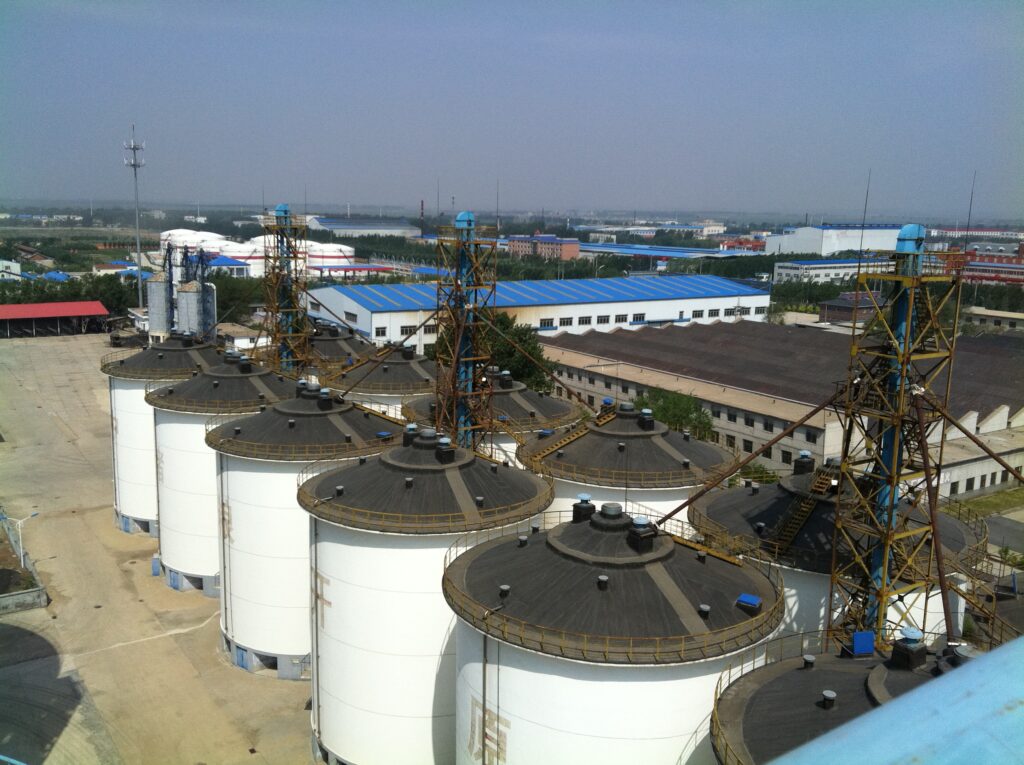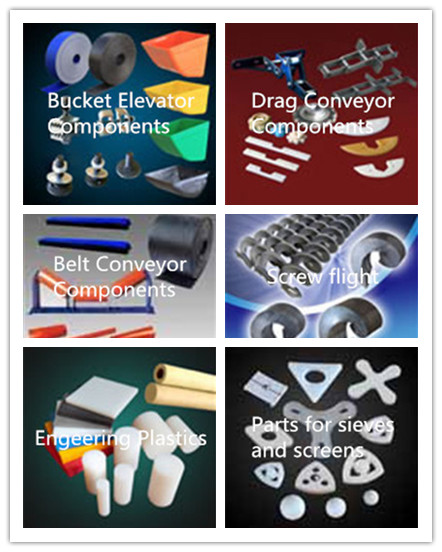
Due to the low cost and high efficiency of bulk grain silo transportation, specialized facilities and equipment such as bulk grain silo terminals and special railway vehicles for bulk grain have been put into production in recent years, and have formed a considerable scale. The proportion has increased to about 60%. In order to adapt to this trend, all ports that use grain as the traditional cargo type have started to build or expand grain transhipment facilities. At present, a large number of grain silos are built or under construction. Bulk grain silo warehousing has received more and more attention as a key process.
Various warehousing processes and equipment
Overlap process of multiple conveyors
This process realizes bulk grain conveying and multi-point unloading through the overlap of the conveyor’s head and tail and the opening and closing of gate valves. It is mainly divided into two ways: belt conveyor overlap and buried scraper conveyor overlap.
The process flow of belt conveyor overlap is as follows:
Belt conveyor A→Two-way valve→Belt conveyor B→Into the grain silo
The overlapping process flow of buried scraper conveyor is as follows:
Buried scraper conveyor A→gate→buried scraper conveyor B→into the silo
When the silo is a steel silo, the buried scraper conveyor lap process is often used, such as Dalian Dayaowan bulk grain steel silo, Qingdao Port steel silo, Guangzhou Port steel silo, Rizhao Lanshan Port steel silo, Shanghai Waigaoqiao Bulk grain project silo also uses buried scraper conveyor overlap technology.
Unloader technology
After the process is lifted to a certain height by the unloading car equipped with a belt conveyor, multi-point unloading is realized under the action of valve distribution. The unloading car process is used in the silo with a closed structure on the upper layer, and is divided into two ways: mobile unloading truck and fixed unloading truck.
The process flow of the mobile unloading truck is as follows (discharge at arbitrary and intentional points in the horizontal section of the conveyor):
Belt conveyor → mobile unloading car → valve → into the grain silo
Typical representative projects include the 400,000 t project of Dalian Beiliang Company, the Bayuquan Port Silo Project of China Grain Storage Yingkou Company, and the Bulk Grain Project of Jinzhou Port.
A typical representative engineering example of fixed unloading vehicles is the reconstruction of the first phase of Dalian Dayao Bay (multiple fixed unloading vehicles). The process flow is as follows:
Belt conveyor → stationary unloading car → valve → belt conveyor into the grain silo
Plow unloading process
The process uses a plough unloader to realize multi-point unloading. There are currently two types of unloading plows, domestically produced and imported. The domestic plow unloader is an auxiliary device in the DTII(A) belt conveyor series, and it also includes the dust cover of the plow unloader and the hopper of the plow unloader.
According to the requirements of the DTII(A) belt conveyor design manual, this plough unloader has two basic forms: single-side and double-side unloading, both of which are variable groove angle unloaders, which are suitable for different belt speeds. It is a conveyor with a size greater than 2.5m/s, a material size of 22mm or less, and a small abrasiveness. The conveyor belt adopts a vulcanized joint. The imported plow unloader is imported with the enclosed belt conveyor, and the principle of multi-point unloading is the same as the domestic one.
Selection of conveying equipment of grain silo
In the past silo design, belt conveyors and buried scraper conveyors are usually used for horizontal conveying equipment, and bucket elevators are used for vertical conveying grain silo equipment. The advantages and disadvantages of these three conveying equipment are described below.
Buried scraper conveyor
Advantages: (1) Simple structure, light weight, small size and space saving; (2) Multi-point feeding and unloading is more convenient for installation and maintenance, easy to operate and realize automatic control, especially suitable for multi-point unloading on the upper level; (3) The airtight performance is good, and the dust is easy to control, which can improve the operating conditions of workers and prevent environmental pollution.
Disadvantages: (1) The horizontal conveying distance is short, the longest is no more than 80m, the vertical lifting height is no more than 30m, and the horizontal installation inclination angle is 0~15°; (2) Due to the friction between the scraper and the trough wall of the material, The parts are easy to wear and consume a lot of power.
Bucket elevator
Advantages: (1) Compact structure, small footprint; (2) Large lifting height, from 5m to 100m; (3) Good airtight performance and large production capacity.
Disadvantages: (1) sensitive to overload and easy to block; (2) buckets and transmission belts are easy to wear, large maintenance, and high maintenance costs; (3) in the design, the size of the working tower often depends on the layout of the bucket elevator. This causes a waste of area, and the working tower usually increases the accumulation of dust in the closed structure, which provides conditions for powder explosion; (4) According to the statistics of powder explosion data at home and abroad, the dust explosion of the vertical grain silo is not well managed and open flame operations. Bucket elevator overload causes belt slippage and generates static electricity, which accounts for a large proportion of dust explosions.
Belt conveyor
Advantages: (1) Low power consumption and low operating cost; (2) Safe operation, long-term operation without damage. Few wearing parts, low maintenance and repair costs; (3) Strong adaptability, can be used as horizontal conveying equipment, and have the ability to climb; (4) Allow a certain range of output changes, not sensitive to overload; (5) It can be arranged in the open air, fully enclosed, and dust does not rise, especially the use of air-cushion belt conveyor, its maintenance and repair costs are greatly reduced, the operation is more stable, reliable, and the conveying volume is large, the noise is low, and the heavy load is easy to start.
Disadvantages: (1) For vertical conveying, belt conveyors have to reach the same lifting height and occupy a larger area than bucket elevators; (2) Unloading trolleys are required for multi-point unloading. In summary, the belt conveyor has an absolute advantage in the conveying equipment. In the design of the port silo, especially when conditions permit, the belt conveyor is used for oblique lifting instead of the bucket elevator, which brings great convenience to management. At the same time, it also reduces the possibility of a powder explosion. The upper layer of the drum also adopts a belt conveyor, which gives full play to the advantages of the belt conveyor and avoids the shortcomings of the buried scraper conveyor with short input distance and high dynamic consumption.
Comparative analysis
The overlapping process of multiple conveyors is suitable for the storage of grain depots and the equipment utilization rate is low. The advantage is that the process layout is simple and can be arranged outdoors. If the grain is fed into the nearest bin (the most favorable working condition), the subsequent equipment can be shut down. Dust removal should adopt a point type dust removal system (plug-in dust collector). Its disadvantages are the large number of equipment, many driving devices, and many control points. If it is the farthest bin feeding grain (the most unfavorable working condition), the preceding equipment must be started. In order to be able to overlap and split, the conveying equipment must be arranged at an angle, and the conveyed materials will be lifted many times, which will result in higher energy consumption . Especially when the conveying material is corn, the crushing rate will increase.
The mobile unloading vehicle technology is suitable for large-scale transit grain depots and port transit depots. Its advantage is “stepless” unloading. When the number of bins is the same, the number of conveying equipment required is the least. It is conventionally arranged in the middle of the two rows of bins, which can realize multiple discharges on both sides of the belt conveyor, and its equipment investment is small. The disadvantage is that the equipment is generally arranged indoors, a warehouse roof needs to be built, and the dust control is difficult, and the requirements for the dust removal system are high.
The plough unloader process is suitable for projects with special requirements from the owner. Its advantage is that it can be arranged outdoors without building a warehouse roof, and it is easy to achieve dust control. The disadvantage is that the belt conveyor needs to be closed, and the supporting silo slide pipe needs to be rainproof, while the imported closed belt conveyor and unloading plough equipment require a large investment. During use, the plough board or tape wears a lot. When conveying corn, the crushing rate is higher than that of the unloading car process.
Conclusion
In summary, the selection of material feeding technology and equipment for the top of the port vertical silo should be based on the different functions of the project, analyze the investment and use costs, meet the special requirements of the owner, and reasonably select the form of multi-point discharge at the top of the silo.
Yutung conveyor manufactures the conveyor and elevator component for grain silo, please refer the link HTTP://www.ytconveyor.com, Email: sales@ytconveyor.com

